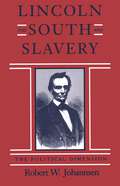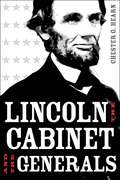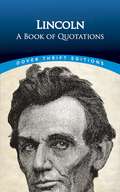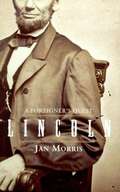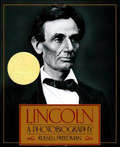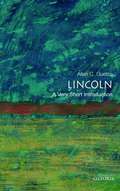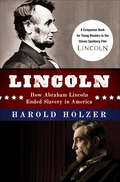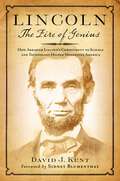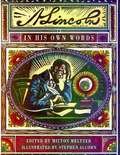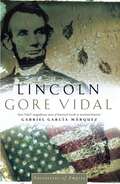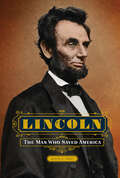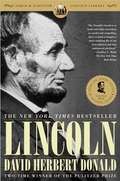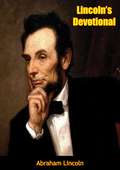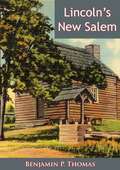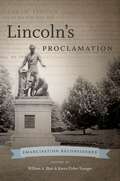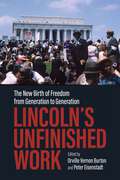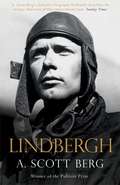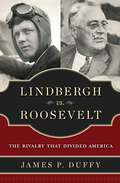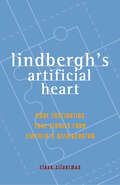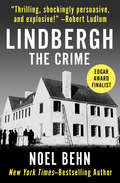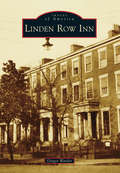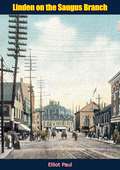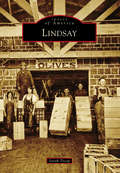- Table View
- List View
Lincoln, The South, and Slavery: The Political Dimension (Walter Lynwood Fleming Lectures In Southern History Ser.)
by Robert W. JohannsenWhereas previous scholars have largely ignored the political character of Lincoln's antislavery argument, Johannsen (history, U. of Illinois) sees Lincoln as an astute and ambitious politician whose statements were delivered almost exclusively during political campaigns to meet political goals. He traces the political dimension of Lincoln's antislavery stance as it evolved from the Kansas-Nebraska Act in 1854 to his election as president in 1860
Lincoln, the Cabinet, and the Generals: A GI's Story of Bataan and Beyond
by Chester G. HearnWhile numerous accounts exist of President Abraham Lincoln's often-troubled dealings with either his cabinet or his generals, Chester G. Hearn's illuminating history provides the first broad synthesis of Lincoln's complex relationship with both groups. As such, it casts new light on much of the behind-the-scenes interplay, intrigue, and sparring between the president and his advisors and military commanders during the most precarious years of the Civil War. Turning first to Lincoln's cabinet, Hearn explains that Lincoln exercised a unique decision-making process: he reached a firm conclusion on an issue, but then he debated it endlessly with his cabinet or generals as if still undecided. To ensure the liveliest discourse, Lincoln appointed as his advisors men with widely differing political motivations. The Republican Lincoln spent four years attempting to bring together his cabinet of former Whigs and Democrats in the spirit of cooperation, but he never completely achieved his purpose. Hearn explores the president's relationship with this cabinet, the problems he encountered selecting it, and the difficulties he experienced attempting to maintain ideological balance while trying to maneuver around those who disagreed with him.Lincoln never broached a subject that did not create some level of dissent within the cabinet, and differences in political philosophy and personal rivalries led to great debate over the running of the administration, the selection of generals, foreign relations and military mobilization, emancipation, freedom of the press, civil rights, and other issues. Still, Hearn asserts, Lincoln's ability to navigate internal scuffles and external turmoil helped to define his presidency.Hearn next demonstrates convincingly that even with these difficulties, Lincoln manipulated his cabinet far more adroitly than he did his generals. Many of Lincoln's top military commanders had political aspirations or agendas of their own, while others were close friends of his intransigent cabinet members. Having assumed the role as de facto army chief, Lincoln took responsibility for the mishandling of battles fought by his generals, some of whom were incompetent and unmanageable politicians. Hearn examines the often-disastrous generalship and its impact on Lincoln and the cabinet, as well as the public, the press, and Congress. Based on over a decade of research, Lincoln, the Cabinet, and the Generals offers both a fresh perspective on and a new interpretation of Lincoln's presidency -- one that reveals the leadership genius as well as the imperfections of America's sixteenth president.
Lincoln-Douglas Debate: Values in Conflict (2nd edition)
by Jeffrey Wiese Stan LewisThis book examines the history and nature of Lincoln-Douglas debate in society and introduces value debate by comparing and contrasting it with policy debate.
Lincoln: A Book Of Quotations (Dover Thrift Editions)
by Bob Blaisdell"All I have learned, I learned from books," declared Abraham Lincoln -- and this book offers ample learning from the sixteenth president's wise and often witty remarks. Drawn from speeches, letters, and other sources, these thoughts and opinions range from considerations of human nature and spirituality to the burdens and privileges of the presidency along with many other topics of enduring interest.Selections include comments on morality ("It has been my experience that folks who have no vices have very few virtues.") and the pursuit of happiness ("Folks are usually about as happy as they make their minds up to be.") as well as friendship ("I'm a success today because I had a friend who believed in me and I didn't have the heart to let him down."), human frailty ("It's not me who can't keep a secret. It's the people I tell that can't."), and other thought-provoking subjects.
Lincoln: A Foreigner's Quest
by Jan MorrisWith a fresh eye and inimitable style, the peerless travel and history writer Jan Morris journeys through the life of Abraham Lincoln to sketch an insightful new portrait of America's sixteenth president, one of our greatest and most enigmatic figures. Looking past his saintly image and log-cabin legend, Morris travels from Lincoln's birthplace to the White House to the infamous Ford Theater and conjures him in public and in private, as politician and as father, as commander-in-chief and as husband. With her skepticism and humor and marvelous sense of place, Morris seamlessly blends narrative, history, and biography to reveal the man behind the myth.
Lincoln: A Photobiography (Journeys 2014)
by Russell FreedmanThe Newbery Medal–winning book for young readers presents &“a human portrait of a politician honorably confronting the most vexing issues of his era&” (The New York Times Book Review). Abraham Lincoln stood out in a crowd as much for his wit and rollicking humor as for his height. This Newbery Medal-winning biography of our Civil War president is warm, appealing, and illustrated with dozens of carefully chosen photographs and prints. Russell Freedman begins with a lively account of Abraham Lincoln's boyhood, his career as a country lawyer, and his courtship and marriage to Mary Todd. Then the author focuses on Lincoln&’s presidency, skillfully explaining the many complex issues he grappled with as he led a deeply divided nation through the Civil War. The book's final chapter is a moving account of his tragic death at Ford's Theatre on April 14, 1865. The volume concludes with a sampling of Lincoln writings and a detailed list of Lincoln historical sites. "Few, if any, of the many books written for children about Lincoln can compare with Freedman's contribution…This is an outstanding example of what (juvenile) biography can be. Like Lincoln himself, it stands head and shoulders above its competition." —School Library Journal
Lincoln: A Very Short Introduction
by Allen C. GuelzoBeneath the surface of the apparently untutored and deceptively frank Abraham Lincoln ran private tunnels of self-taught study, a restless philosophical curiosity, and a profound grasp of the fundamentals of democracy. Now, in Lincoln: A Very Short Introduction, the award-winning Lincoln authority Allen C. Guelzo offers a penetrating look into the mind of one of our greatest presidents. If Lincoln was famous for reading aloud from joke books, Guelzo shows that he also plunged deeply into the mainstream of nineteenth-century liberal democratic thought. Guelzo takes us on a wide-ranging exploration of seven problems that confronted Lincoln and liberal democracy--equality, opportunity, the rule of law, slavery, freedom, and reconciliation. The book sets these problems and Lincoln's responses against the larger world of American and trans-Atlantic liberal democracy in the 19th century, comparing Lincoln not just to Andrew Jackson or John Calhoun, but to British thinkers such as Richard Cobden, Jeremy Bentham, and John Bright, and to French observers Alexis de Tocqueville and Francois Guizot. The Lincoln we meet here is an Enlightenment figure who struggled to create a common ground between a people focused on individual rights and a society eager to establish a certain moral, philosophical, and intellectual bedrock. Lincoln insisted that liberal democracy had a higher purpose, which was the realization of a morally right political order. But how to interject that sense of moral order into a system that values personal self-satisfaction--"the pursuit of happiness"--remains a fundamental dilemma even today. Abraham Lincoln was a man who, according to his friend and biographer William Henry Herndon, "lived in the mind." Guelzo paints a marvelous portrait of this Lincoln--Lincoln the man of ideas--providing new insights into one of the giants of American history.
Lincoln: How Abraham Lincoln Ended Slavery in America
by Harold HolzerA new book—and companion to the Steven Spielberg film—tracing how Abraham Lincoln came to view slavery . . . and came to end it.Steven Spielberg focused his movie Lincoln on the sixteenth president's tumultuous final months in office, when he pursued a course of action to end the Civil War, reunite the country, and abolish slavery. Invited by the filmmakers to write a special Lincoln book as a companion to the film, Harold Holzer, the distinguished historian and a consultant on the movie, now gives us a fast-paced, exciting new book on Lincoln's life and times, his evolving beliefs about slavery, and how he maneuvered to end it.The story starts on January 31, 1865—less than three months before Lincoln's assassination—as the president anxiously awaits word on whether Congress will finally vote to pass the Thirteenth Amendment to the Constitution. Although the Emancipation Proclamation two years earlier had authorized the army to liberate slaves in Confederate territory, only a Constitutional amendment passed by Congress and ratified by three-fourths of the states would end slavery legally everywhere in the country.Drawing from letters, speeches, memoirs, and documents by Lincoln and others, Holzer goes on to cover Lincoln's boyhood, his moves from Kentucky to Indiana to Illinois, his work as a lawyer and congressman, his unsuccessful candidacies for the U.S. Senate and his victory in two presidential elections, his arduous duties in the Civil War as commander in chief, his actions as president, and his relationships with his family, political rivals, and associates. Holzer provides a fresh view of America in those turbulent times, as well as fascinating insights into the challenges Lincoln faced as he weighed his personal beliefs against his presidential duties in relation to the slavery issue.The passage of the Thirteenth Amendment would become the crowning achievement of Abraham Lincoln's life and the undisputed testament to his political genius. By viewing his life through this prism, Holzer makes an important passage in American history come alive for readers of all ages.The book also includes thirty historical photographs, a chronology, a historical cast of characters, texts of selected Lincoln writings, a bibliography, and notes.
Lincoln: How Abraham Lincoln's Commitment to Science and Technology Helped Modernize America
by David J. KentAbraham Lincoln had a lifelong fascination with science and technology, a fascination that would help institutionalize science, win the Civil War, and propel the nation into the modern age. Readers will learn through Lincoln: The Fire of Genius how science and technology gradually infiltrated Lincoln&’s remarkable life and influenced his growing desire to improve the condition of all men. The book traces this progression from a simple farm boy to a president who changed the world. Counter to conventional wisdom, subsistence farming provides a considerable education in agronomic science, forest ecology, hydrology, and even a little civil engineering. Continuing through a lifetime of self-study, curiosity, and hard work, Lincoln became the only President with a patent, advocated for technological advancement as a legislator in Illinois and in Washington, and became the &“go-to&” western lawyer on technology, and patent cases during his legal career. During the Civil War, Lincoln drew upon his commitment to science and personally encouraged inventors while taking dramatic steps to institutionalize science via the Smithsonian Institution, create the National Academy of Sciences, and initiate the Department of Agriculture. Lincoln&’s insistence on high-tech weaponry, balloon surveillance, strategic use of telegraphy, and railroad deployment positioned the North to achieve Union victory.
Lincoln: In His Own Words
by Milton MelzerCombines background commentary with quotes from Lincoln's letters, speeches, and public papers to provide a personal view of his life, thoughts, and actions.
Lincoln: Number 2 in series (Narratives of empire)
by Gore VidalIn the hazardous fictional terrain of his historical novels, Gore Vidal is never especially kind to American history in general, or to its icons in particular. Yet in this brilliantly realised study of Abraham Lincoln, he paints a surprising and near-heroic picture of the man who led America through four of the most divisive and dangerous years of the nation's history. Observed alternately by his loved ones, his rivals and his future assassins, Lincoln at first appears as an inept and naïve backwoods lawyer. People in this novel are not averse to turning up, getting drunk, and regaling the reader with details of Lincoln's whoring activities and his seemingly inexhaustible supply of folksy stories. Yet gradually Lincoln the towering leader of deep vision emerges in a Washington engulfed by fear, greed and the horrors of the Civil War. Lincoln's loving but mentally decomposing wife, his view from the White House on slavery and America's bloodiest war, and his own, fierce personal ambition: all are portrayed with a vibrancy and an urgency that almost belies what they have now become ? history itself.
Lincoln: The Man Who Saved America (Illustrated Lives)
by David J KentA lively, illustrated biography of America’s 16th president from his humble beginnings to his historic leadership during the Civil War.Abraham Lincoln was, to put it mildly, an unlikely candidate for president. Raised on the frontier and mostly self-taught, the gangly farmer had little in common with the Founding Fathers, with one exception: a deep and abiding belief in America’s still-fragile experiment in democracy. Turning his quick mind and gregarious personality to politics, Lincoln ascended through state and national government, before being elected president in 1860 on the eve of the Civil War. During that bloody and devastating conflict, Lincoln’s tenacity, strategic brilliance, and plain-spoken eloquence not only helped keep the nation together through its darkest hours but also set the course for a reconciliation that he would not live to see. Filled with historical drama and packed with rare illustrations, Lincoln: The Man Who Saved America weaves the fascinating biography of Abraham Lincoln into the story of the most perilous period in American history.
Lincoln: Two Glimpses Of Abraham Lincoln's Family Life
by David Herbert DonaldDavid Herbert Donald's Lincoln is a stunningly original portrait of Lincoln's life and presidency. Donald brilliantly depicts Lincoln's gradual ascent from humble beginnings in rural Kentucky to the ever- expanding political circles in Illinois, and finally to the presidency of a country divided by civil war. Donald goes beyond biography, illuminating the gradual development of Lincoln's character, chronicling his tremendous capacity for evolution and growth, thus illustrating what made it possible for a man so inexperienced and so unprepared for the presidency to become a great moral leader. In the most troubled of times, here was a man who led the country out of slavery and preserved a shattered Union -- in short, one of the greatest presidents this country has ever seen.
Lincolnomics: How President Lincoln Constructed the Great American Economy
by John F. WasikA biography of Abraham Lincoln that examines his untold legacy as the Great Builder of American infrastructure. Abraham Lincoln&’s view of the right to fulfill one&’s economic destiny was at the core of his governing philosophy―but he knew no one could climb that ladder without strong federal support. Some of his most enduring policies came to him before the Civil War, visions of a country linked by railroads running ocean to ocean, canals turning small towns into bustling cities, public works bridging farmers to market. Expertly appraising the foundational ideas and policies on infrastructure that America&’s sixteenth president rooted in society, John F. Wasik tracks Lincoln from his time in the 1830s as a young Illinois state legislator pushing internal improvements; through his work as a lawyer representing the Illinois Central Railroad in the 1840s; to his presidential fight for the Transcontinental Railroad; and his support of land-grant colleges that educated a nation. To Lincoln, infrastructure meant more than the roads, bridges, and canals he shepherded as a lawyer and a public servant. These brick-and-mortar developments were essential to a nation&’s lifting citizens above poverty and its isolating origins. Lincolnomics revives the disremembered history of how Lincoln paved the way for Eisenhower&’s interstate highways and FDR&’s social amenities. With an afterword addressing the failure of American infrastructure during the COVID-19 pandemic, and how Lincoln&’s policies provide a guide to the future, Lincolnomics makes the case for the man nicknamed &“The Rail Splitter&” as the Presidency&’s greatest builder. &“In this unique blend of biography and policy prescription, journalist Wasik . . . casts Abraham Lincoln as America&’s &“foremost moral architect of economic and social opportunity&” and looks to his life and political career for lessons in how the nation might rebuild its infrastructure and redress income inequality. . . . Wasik convincingly argues that [Lincoln&’s] economic policies deserve more credit.&” —Publishers Weekly &“While revealing as history, Wasik&’s account about the first Republican President&’s launches of infrastructure shame the ignorant, obstinate, narcissist Republicans of today who wish instead to build up tyrant Trump&’s political infrastructure. This is a book to be read and used today.&” —Ralph Nader &“Wasik invented a new word for this book because his theme bears new force: Abraham Lincoln sought a better-built nation and a freer legal space to help every individual, regardless of background, to aspire and rise. Most historians know this too vaguely about Lincoln; Wasik finally gives the great democratic idea the prominence it deserves.&” —James M. Cornelius, Ph.D., editor, Journal of the Abraham Lincoln Association
Lincoln’s Devotional: The Believer's Daily Treasure
by Abraham LincolnThe discovery of Abraham Lincoln’s personal, signed copy of a charming “vest-pocket” devotional has excited the public and historians alike—for here is new testimony to the depth of Lincoln’s faith, new light in an area previously clouded by uncertainty.In his moving introduction to this faithful edition of the 100-year-old book of daily Scriptural messages and inspirational verse, Carl Sandburg knits together fact and conjecture about Lincoln’s religious feelings. We are able to picture Abraham Lincoln carrying this little volume with him as he traveled the old Eighth Circuit; we learn of his familiarity with verses he could encounter in its pages.LINCOLN’S DEVOTIONAL contains a facsimile of Lincoln’s signature on the flyleaf, as he wrote it in his own copy.
Lincoln’s New Salem
by Benjamin P. ThomasOriginally published in 1956, in this book Benjamin P. Thomas tells the story of the village where Abraham Lincoln lived from 1831 to 1837. His three-part examination of the village often referred to as Lincoln’s “Alma Mater” features the founding and early history of New Salem, Lincoln’s impact on the village and its effect on him, and the story of the Lincoln legend and the reconstruction of the town.Thomas argues convincingly that New Salem was the town where Lincoln acquired faith in himself, faith in people. At 22 the future president drifted into town seeking to become a blacksmith. Thomas introduces us to the people who created New Salem and who knew, influenced, and befriended Lincoln.Thomas highlights Lincoln’s arrival, his relationships with his neighbors, his important wrestling match with Jack Armstrong, his self-education, his quiet career as an Indian fighter, his experience as a postmaster largely indifferent to postal regulations, his financial woes as a businessman, his loyal friends who often came to his aid, and his election to the legislature.This colorful history closes with a discussion of the Lincoln legend. The truth of the stories is unimportant. What matters is that the growing Lincoln legend prompted the gradual realization that New Salem was not a dismal mire from which President Lincoln had had to extricate himself but was, in fact, an energizing force. This realization led to research and finally to the restoration of New Salem, which began in 1932.“No other portion of Lincoln’s life lends itself so readily to intensive study of his environment as do his six years at New Salem.”—Benjamin P. Thomas, Foreword
Lincoln’s Proclamation
by William A. Blair Karen Fisher YoungerThe Emancipation Proclamation, widely remembered as the heroic act that ended slavery, in fact freed slaves only in states in the rebellious South. True emancipation was accomplished over a longer period and by several means. Essays by eight distinguished contributors consider aspects of the president's decision making, as well as events beyond Washington, offering new insights on the consequences and legacies of freedom, the engagement of black Americans in their liberation, and the issues of citizenship and rights that were not decided by Lincoln's document. The essays portray emancipation as a product of many hands, best understood by considering all the actors, the place, and the time. The contributors are William A. Blair, Richard Carwardine, Paul Finkelman, Louis Gerteis, Steven Hahn, Stephanie McCurry, Mark E. Neely Jr., Michael Vorenberg, and Karen Fisher Younger.
Lincoln’s Unfinished Work: The New Birth of Freedom from Generation to Generation
by Eric Foner Richard Carwardine Mark Schultz Jerald Podair Gavin Wright Stephen Kantrowitz William Haller J. William Harris Randall Stephens Joshua Casmir Catalano Greg Downs James Loewen Lawrence McDonnell Adrienne Petty Briana Pocratsky Rhondda ThomasIn his Gettysburg Address, Abraham Lincoln promised that the nation’s sacrifices during the Civil War would lead to a “new birth of freedom.” Lincoln’s Unfinished Work analyzes how the United States has attempted to realize—or subvert—that promise over the past century and a half. The volume is not solely about Lincoln, or the immediate unfinished work of Reconstruction, or the broader unfinished work of America coming to terms with its tangled history of race; it investigates all three topics.The book opens with an essay by Richard Carwardine, who explores Lincoln’s distinctive sense of humor. Later in the volume, Stephen Kantrowitz examines the limitations of Lincoln’s Native American policy, while James W. Loewen discusses how textbooks regularly downplay the sixteenth president’s antislavery convictions. Lawrence T. McDonnell looks at the role of poor Blacks and whites in the disintegration of the Confederacy. Eric Foner provides an overview of the Constitution-shattering impact of the Civil War amendments. Essays by J. William Harris and Jerald Podair examine the fate of Lincoln’s ideas about land distribution to freedpeople. Gregory P. Downs focuses on the structural limitations that Republicans faced in their efforts to control racist violence during Reconstruction. Adrienne Petty and Mark Schultz argue that Black land ownership in the post-Reconstruction South persisted at surprisingly high rates. Rhondda Robinson Thomas examines the role of convict labor in the construction of Clemson University, the site of the conference from which this book evolved. Other essays look at events in the twentieth and twenty-first centuries. Randall J. Stephens analyzes the political conservatism of white evangelical Christianity. Peter Eisenstadt uses the career of Jackie Robinson to explore the meanings of integration. Joshua Casmir Catalano and Briana Pocratsky examine the debased state of public history on the airwaves, particularly as purveyed by the History Channel. Gavin Wright rounds out the volume with a striking political and economic analysis of the collapse of the Democratic Party in the South.Taken together, the essays in this volume offer a far-reaching, thought-provoking exploration of the unfinished work of democracy, particularly as it pertains to the legacy of slavery and white supremacy in America.
Lindbergh vs. Roosevelt: The Rivalry That Divided America
by James P. DuffyWas aviation pioneer and popular American hero Charles A. Lindbergh a Nazi sympathizer and anti-Semite? Or was he the target of a vicious personal vendetta by President Roosevelt? In Lindbergh vs. Roosevelt, author James Duffy tackles these questions head-on, by examining the conflicting personalities, aspirations, and actions of Franklin D. Roosevelt and Charles A. Lindbergh. Painting a politically incorrect portrait of both men, Duffy shows how the hostility between these two American giants divided the nation on both domestic and international affairs. From canceling U.S. air mail contracts to intervening in World War II, Lindberg and Roosevelt's clash of ideas and opinions shaped the nation's policies here and abroad. Insightful, and engaging, Lindbergh vs. Roosevelt reveals the untold story about two of history's most controversial men, and how the White House waged a smear campaign against Lindbergh that blighted his reputation forever.
Lindbergh's Artificial Heart: More Fascinating True Stories from Einstein's Refrigerator
by Steve SilvermanAn all-new compendium of strange-but-true history and science facts from the author of Einstein&’s Refrigerator. When high school teacher Steve Silverman started posting fascinating facts on the internet, what began as a Web site for his students became an internationally sensation. He then compiled the silliest, most peculiar stories into the book Einstein's Refrigerator. Now comes silliness squared with Lindbergh's Artificial Heart, Silverman's second collection of offbeat and often hilarious stories that are absolutely true, yet not often taught in school. Fascinating entries include: The exploding whale: What did the Oregon Department of Transportation do with a dead whale that washed up on one of its beaches? Suffice it to say their decision to blow it up was quite the blubber blunder. Nose picking: Delve into the humorous findings of a study of this bad habit conducted by one of our institutions of higher learning. The fastest charcoal lighter ever: Using liquid oxygen at your family barbecue may speed up the cooking, but it does have its drawbacks . . . such as vaporizing your grill.
Lindbergh: The Crime
by Noel BehnEdgar Award Finalist: This &“sensational&” and &“absolutely compelling&” true crime tale finally answers the question: Who really killed the Lindbergh baby? (San Francisco Chronicle). On the night of March 1, 1932, celebrated aviator Charles Lindbergh&’s infant son was kidnapped from his New Jersey home. The family paid $50,000 to get &“Little Lindy&” back, but his remains were discovered in a grove of trees four miles from the Lindbergh house. More than two years after the abduction, Bruno Hauptmann, an unemployed carpenter and illegal German immigrant, was caught with $20,000 of the ransom money. He was arrested, tried, and executed for the crime. But did he really do it? New York Times–bestselling author Noel Behn spent eight years investigating the case, revisiting old evidence, discovering new information, and shining a bright light on the controversial actions of public figures such as New Jersey Governor Harold Hoffman, FBI Director J. Edgar Hoover, New Jersey State Police Superintendent H. Norman Schwarzkopf, and Charles Lindbergh himself. The result is a fascinating and convincing new theory of the crime that exonerates Hauptmann and names a killer far closer to the Lindbergh family. A finalist for the Edgar Award, Lindbergh &“not only provides answers to the riddles of the &‘Crime of the Century,&’ but hurls us into time past, to a special moment in American history&” (Peter Maas, New York Times–bestselling author of Underboss).
Linden Row Inn
by Ginger WarderIncluded in the National Register of Historic Places, the collection of Greek Revival row houses that make up the Linden Row Inn have played a significant role in the history of Richmond, Virginia, for two centuries. As a child, Edgar Allan Poe played in the private garden that occupied this site, and he later courted his first love, Elmira Royster, among the roses and linden trees. During the Civil War, Linden Row was a meeting place for leaders and supporters of the Confederacy; later, it was home to a prestigious girls' school, whose pupils included Irene and Nancy Langhorne, known in later years as the Gibson Girl and Lady Nancy Astor. In 1922, two of the original ten houses were torn down and replaced by the Medical Arts Building. In 1950, local preservationist Mary Wingfield Scott purchased the remaining houses to save them from the wrecking ball, donating them in 1980 to the Historic Richmond Foundation. In 1988, under the supervision of the foundation, seven of the eight remaining houses were renovated and restored to become the Linden Row Inn, which still welcomes travelers today.
Linden on the Saugus Branch (American Autobiography Ser.)
by Elliot PaulThat you will be completely charmed by Elliot Paul’s recollections of his boyhood is a matter beyond speculation. The turn-of-the-century scenes are not only dear to his heart but clear to his mind—albeit sometimes suspiciously so. But who will quarrel with so elegant a storyteller as Mr. Paul? Out of the sow’s ear of common occurrence he makes a silken purse to hold the coins of our enchantment. Rare is the reader who will not delight in these fortified memories.Those who recall The Last Time I saw Paris know that Elliot Paul is incapable of being banal or tiresome. Thus there is nothing of the diary-like march of events in this record of his early years in the Boston suburb where he was born. Instead you will find a series of neatly dovetailed stories, anecdotes, character sketches, comedies, tragedies and singularly embellished observations all set out for your allurement like gems in a jeweler’s window.Some of Mr. Paul’s tales of the people who lived out their lives in Linden will make you laugh, some may even tempt a tear. There are a few—such as the story of Alice Townsend, the schoolteacher who found that her name had been written in snow with a stylus of strange origin—that may inspire the sincerest suggestion of a blush.Linden on the Saugus Branch, a volume complete in itself, is another segment in what will ultimately be Elliot Paul’s life story: Items on the Grand Account. Both The Last Time I Saw Paris and The Life and Death of a Spanish Town are other books in this group.
Lindsay (Images of America)
by Sarah TroopA picturesque town nestled among the wildflower-covered foothills of the Sierras, Lindsay is the epitome of the ideal California life--one of health, wealth and sunshine. Lindsay became the heart of the state's second gold rush, when large-scale farming became popular, by hitting the mother lode with oranges. With over 16 citrus packinghouses, people initially came to Lindsay to seek their fortune. The success of the citrus groves attracted not only many skilled Japanese farmers but also many immigrants who were new to the trade. By the 1920s, Lindsay's most famous crop became Lindsay Ripe Olives. Lindsay is a town of surprising inventions and innovations that revolutionized agriculture, citrus farming, irrigation, and especially the olive industry.
